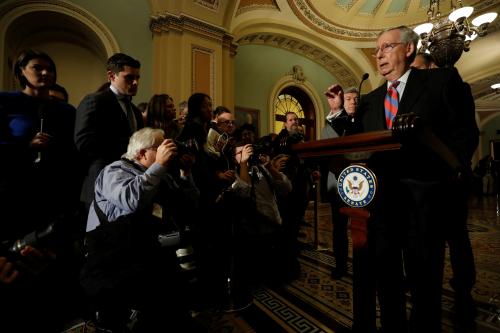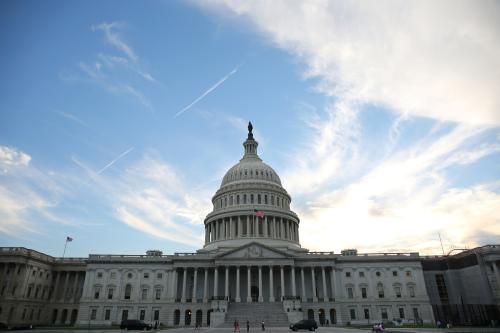The tax bill speeding through Congress is being sold – by its advocates – as so good for the economy, that it will boost growth and offset any losses from the cuts. Those of you who were around in the 1980s might be feeling a sense of deja vu, especially when you recall what Ronald Reagan had to say back in 1981.
“We presented a complete program of reduction in tax rates. Again, our purpose was to provide incentive for the individual, incentives for business to encourage production and hiring of the unemployed, and to free up money for investment.”
I revisited the 1980s in a recent conversation with NPR’s Morning Edition. You can listen here. Here’s the gist of what I had to say.
Q. Did the 1981 Reagan tax cut spur enough economic growth that it paid for itself?
A. When Ronald Reagan arrived in Washington in 1981, circumstances were very different than they are today. Inflation was nearly 10 percent. The Federal Reserve had pushed interest rates into double digits. The federal debt was about half what it is today, measured as a share of the economy. The Reagan tax cut was huge. The top rate fell from 70 percent to 50 percent. The tax cut didn’t pay for itself. According to later Treasury estimates, it reduced federal revenues by about 9 percent in the first couple of years. In fact, most of the top Reagan administration officials didn’t think the tax cut would pay for itself. They were counting on spending cuts to avoid blowing up the deficit. But they never materialized.
Q. So the spending cuts never materialized, the deficit increased, and then what?
A. As projections for the deficit worsened, it became clear that the 1981 tax cut was too big. So with Reagan’s signature, Congress undid a good chunk of the 1981 tax cut by raising taxes a lot in 1982, 1983, 1984 and 1987. George H.W. Bush signed another tax increase in 1990 and Bill Clinton did the same in 1993. One lesson from that history: When tax cuts are really too big to be sustainable, they’re often followed by tax increases.
Q. But wasn’t there an economic boom in the 1980s?
A. What the 1980s teach is that you can’t look at taxes in isolation. The Fed’s war on inflation pushed interest rates to nearly 20 percent and provoked a severe double-dip recession, one of the worst of the post-World War II era. Uemployment rose above 10 percent in 1982 and 1983. When the Fed cut rates, the economy took off. The tax cuts undoubtedly contribute. So did big increases in federal spending on defense and highways. Many of the business tax breaks in the 1981 bill didn’t survive so it’s hard to see how they helped much.
Q. Current Republicans in Congress have compared this tax bill to the Tax Reform Act of 1986. Is that a fair comparison?
The fact that we haven’t done real tax reform for three decades is a reminder that tax reform is hard because there are so many losers as well as winners.
A. The fact that we haven’t done real tax reform for three decades is a reminder that tax reform is hard because there are so many losers as well as winners. The 1986 bill was very different than this year’s tax bill. One, it was preceded by a couple of years of ground work by tax experts at the Treasury. Two, it was bipartisan. And, three, it was intended to improve the tax code but to raise just as much money as the then-existing tax code did – no more and no less. And was designed to be “distributionally neutral” – that is, to avoid shifting the tax burden from rich to poor or from poor to rich. It basically raised taxes on business and curtailed a lot of tax shelters to pay for a tax cut for individuals. The top rate fell from 50 percent, where Reagan had left it, to 33 percent.
Q. Did the 1986 reform deliver on its promises?
A. Ronald Reagan said the goal was “fairness, simplicity and economic growth.” Did it achieve those goals? Well, it removed a lot of barnacles from the tax code and that improved the tax code. But did it lead to a lot of economic growth? That’s hard to see. A couple of eminent tax economists, Alan Auerbach at the University of California, Berkeley, and Joel Slemrod at the University of Michigan, concluded in a 1997 retrospective in the Journal of Economic Literature:
“Of course, saying that a decade of analysis has not taught us much about whether TRA86 was a good idea is not at all the same as saying it was not in fact a good idea. We think it was. The theoretical case remains valid for a tax system with a broad and clean base which minimizes the reward to tax-driven economic activity. Advocates of this kind of tax system will, however, be frustrated that a retrospective analysis of the most comprehensive attempt in history to achieve this goal offers little hard evidence of the fruits of this effort.”
One lesson from this: Despite all the rhetoric over the economic effects of big tax bills, taxes are only one of many factors that drive the economy – and probably not as big a factor as you’d think when listening the debate when those bills are pending in Congress.
The Brookings Institution is committed to quality, independence, and impact.
We are supported by a diverse array of funders. In line with our values and policies, each Brookings publication represents the sole views of its author(s).






Commentary
What we learned from Reagan’s tax cuts
December 8, 2017